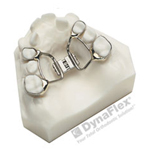April 6th, 2015
 As the nation prepares to observe the 16th Oral Caner Awareness Month this April, the Academy of General Dentistry, the American Academy of Oral and Maxillofacial Pathology, the American Academy of Oral Medicine, the American Association of Oral and Maxillofacial Surgeons, the American Dental Association and the American Dental Hygienists' Association have joined the Oral Cancer Foundation in its campaign to raise awareness of this silent killer.
As the nation prepares to observe the 16th Oral Caner Awareness Month this April, the Academy of General Dentistry, the American Academy of Oral and Maxillofacial Pathology, the American Academy of Oral Medicine, the American Association of Oral and Maxillofacial Surgeons, the American Dental Association and the American Dental Hygienists' Association have joined the Oral Cancer Foundation in its campaign to raise awareness of this silent killer.
Be mindful of symptoms
The mouth is one of your body's most important early warning systems. Between dental visits, it is importance that you be aware of the following signs and symptoms, and see a dental professional if they do not improve or disappear after two to three weeks:
- A sore, or soreness or irritation that doesn't go away
- Red or white patches, or pain, tenderness, or numbness in mouth or lips
- Lumps, thickening tissues, rough spots, crusty or eroded areas
- Difficulty chewing, swallowing, speaking or moving your jaw or tongue
- A change in the way your teeth fit together when you close your mouth
Factors that may increase your risk of oral cancer
Research has identified a number of factors that may contribute to the development of oral cancer. Historically, those at an especially high risk have been heavy alcohol drinkers and smokers older than age 50, but today the cancer also is occurring more frequently in younger, non smoking people. The human papillomavirus 16 (HPV) is related to the increasing incidence of oropharyngeal cancer (most commonly involving tonsillar tissue, including the base of the tongue) in the younger population.
If you have never had an oral cancer examination, there is no better time to schedule one than during Oral Cancer Awareness Month in April! When you do, be sure to ask that this examination be made routine at all your future dental checkups.
March 4th, 2015
 One of the most common orthodontic appliances used in children is the palatal expander. Arch expansion is one of the most common ways to eliminate mild/moderate crowding and cross-bites in growing patients. Successful expansion requires that the growth plate in the roof of the mouth (the midpalatal suture) is not fused. This fusion usually occurs between age 14-16. An expander is attached to the upper arch by bands placed around the first molars (and in some cases around the 1st premolars if they are erupted). Although there are removable expanders, fixed ones have an importance advantage in that they cannot be lost or forgotten.
One of the most common orthodontic appliances used in children is the palatal expander. Arch expansion is one of the most common ways to eliminate mild/moderate crowding and cross-bites in growing patients. Successful expansion requires that the growth plate in the roof of the mouth (the midpalatal suture) is not fused. This fusion usually occurs between age 14-16. An expander is attached to the upper arch by bands placed around the first molars (and in some cases around the 1st premolars if they are erupted). Although there are removable expanders, fixed ones have an importance advantage in that they cannot be lost or forgotten.
Interestingly, the lower jaw (mandible) is not amenable to expansion. The suture in the mandible fuses soon after birth so true expansion is not able to occur. If the back teeth have an excess tip inwards (Curve of Wilson), then a Swartz removable expander is useful to upright teeth to the ideal position. This does allow some space creation in the front teeth as well.
Expanders are relatively painless for our patients. Some report that they feel pressure on the teeth, in the roof of the mouth, behind the nose, and even between the eyes as their expander is activated (or turned). This pressure fades within minutes. Besides pressure, we also tell parents to expect the child to speak differently for the first few days. Additional saliva production may also occur as well as slight modifications to eating. One of the most visible signs that the suture is opening (the desired effect) is the appearance of a space between the upper central incisors. Once the expansion is complete, it is normal for the space to close spontaneously. This occurs as the elastics fibers surrounding the gingival tissues return to their original positions. The underlying bone, however, remains expanded. It is normal for the anterior teeth to feel slightly loose and sore as they move together.
Because there is always some relapse, I generally choose to over-expand the palate slightly and then hold the expander in place for an additional 4-6 months. Following the removal of the expander, I will provide a Hawley retainers that is to be worn at night (of after school and night) so as to ensure the stability of the correction and then follow the patients quarterly until they are ready for comprehensive orthodontic evaluation (when all the permanent teeth erupt).
As always, if you have any questions about this appliance or any orthodontic treatment, please don't hesitate to talk to Dr. Hughes or one of the assistants at the office.
February 2nd, 2015
 Each February, the American Dental Association (ADA) sponsors National Children's Dental Health Month to raise awareness about the importance of oral health. Developing good habits at an early age and scheduling dental visits helps children get a good start on a lifetime of healthy teeth and gums. As an active member of the ADA, Dr. Hughes strongly supports this effort! She and Brandy will be headed out to the local Natick schools this month to hand out toothbrushes, dental information and give fun class room presentations on dental health. Hope everyone has a wonderful February and don't forget to brush 2 times a day for 2 minutes (that's 4 times a day for those of you with braces), floss once a day and see your dentist at least every 6 months.
Each February, the American Dental Association (ADA) sponsors National Children's Dental Health Month to raise awareness about the importance of oral health. Developing good habits at an early age and scheduling dental visits helps children get a good start on a lifetime of healthy teeth and gums. As an active member of the ADA, Dr. Hughes strongly supports this effort! She and Brandy will be headed out to the local Natick schools this month to hand out toothbrushes, dental information and give fun class room presentations on dental health. Hope everyone has a wonderful February and don't forget to brush 2 times a day for 2 minutes (that's 4 times a day for those of you with braces), floss once a day and see your dentist at least every 6 months.
December 31st, 2014
Do you have a New Year goal or wish? Post it on our Facebook page or stop by the office and place in our contest jar to be entered into chance to win a gift card for two Snow Tubing passes to Ward Hill Ski Area.
 As the nation prepares to observe the 16th Oral Caner Awareness Month this April, the Academy of General Dentistry, the American Academy of Oral and Maxillofacial Pathology, the American Academy of Oral Medicine, the American Association of Oral and Maxillofacial Surgeons, the American Dental Association and the American Dental Hygienists' Association have joined the Oral Cancer Foundation in its campaign to raise awareness of this silent killer.
As the nation prepares to observe the 16th Oral Caner Awareness Month this April, the Academy of General Dentistry, the American Academy of Oral and Maxillofacial Pathology, the American Academy of Oral Medicine, the American Association of Oral and Maxillofacial Surgeons, the American Dental Association and the American Dental Hygienists' Association have joined the Oral Cancer Foundation in its campaign to raise awareness of this silent killer.


